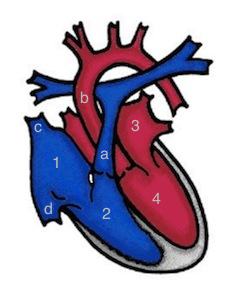Anatomy
The normal heart is a hollow muscular organ that receives blood from the veins and pumps it into the arteries. The heart of an adult beats more than 100,000 times a day, in a child it beats even more frequently.
The heart is divided by partitions into a right and a left half, each half consisting of an atrium and a ventricle. The blood flows from the veins into the atria and through heart valves into the ventricles, which pump the blood from the heart into the lungs (through the pulmonary artery) or into the body (through the aorta).

1 - right atrium
2 - right ventricle
3 - left atrium
4 - left ventricle
a - pulmonary artery
b - main body artery (= aorta)
c - superior vena cava
d - inferior vena cava
Circulation
The left atrium receives oxygen-rich blood from the lungs. This blood passes through the mitral valve into the left ventricle. This is the main pumping chamber of the heart and pumps the oxygen-rich blood through the aorta into the arteries and finally into all of the body's tissues.
After the blood has delivered the vital oxygen to the tissues and absorbed metabolic waste products, it flows back to the heart via the veins. The deoxygenated blood from the lower half of the body reaches the right atrium via the inferior vena cava and the deoxygenated blood from the upper half of the body via the superior vena cava.
From the right atrium, the deoxygenated blood flows through the tricuspid valve into the right ventricle, which pumps the blood into the pulmonary artery. The pulmonary artery divides into the right and left pulmonary arteries, which carry the blood to the right and left lungs. This is where the gas exchange takes place, i.e. oxygen is absorbed into the blood and carbon dioxide is released and then exhaled.
The oxygen-rich "fresh" blood returns to the heart in the left atrium via the pulmonary veins.